2.1: Expressions Utiles
- Page ID
- 142290
Expressions Utiles
Please remember that these expressions are to be memorized, not "learned" in the sense of explicitly understanding their grammatical structure. In this set we continue to provide classroom expressions, including the expression for asking how to say something in French. We encourage you to use "Comment dit-an X en français" when you want to know the French word for a common item or how to say something simple, such as "She's my aunt" (= C'est ma tante).
| Répondez à la question. | Answer the question. |
| Dites la même chose à votre voisin(e). | Say the same thing to the person sitting next to you. |
| Comment dit-on "happy" en français? | How do you say "happy" in French? |
| On dit "heureux." | They say "heureux." |
| Vous avez compris? | Did you understand? |
| Tu as compris? | You understood? |
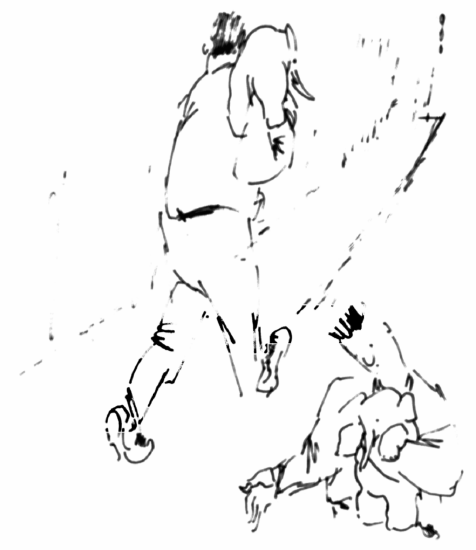
Dialogue
A student carrying an elephant meets his professor, and the professor thinks he must be tired from carrying such a heavy object.
- —Bonjour, Philippe.
- —Bonjour, Madame.
- —Qu est-ce que c'est. Philippe? (pointing at the elephant)
- —C'est un éléphant.
- —Ah! Comment s'appelle-t-il?
- —Il s'appelle Toto.
- —Vous êtes fatigué, n'est-ce pas?
- —Non, Toto est petit.
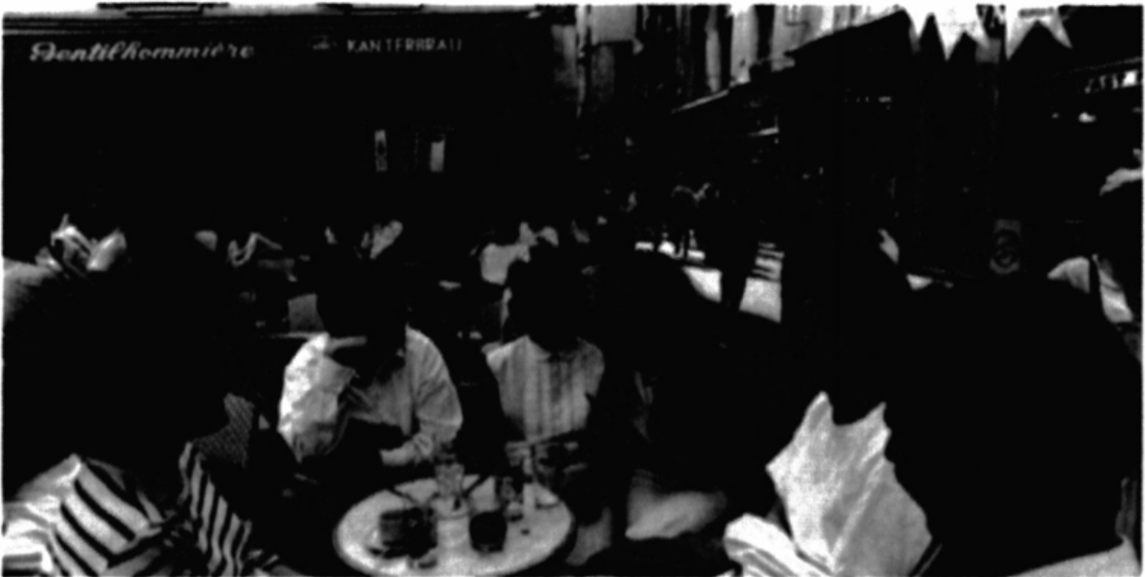
Figure 2.2. On boit un pot.
Questions et réponses
A. How old are you?
| —(M B***), quel age avez-vous? | teacher to student |
| —J'ai __ ans. | student to teacher |
(Your instructor will repeat the first set with a number of students, pay attention and try to remember the answers given.)
| —Quel âge a-t-elle? | teacher to student, re: other student, f. |
| —Elle a __ ans. | |
| —Quel âge a-t-il? | |
| —Il a __ ans. | |
| —Posez la même question à votre voisin(e). | |
| —Quel âge as-tu? | student to student |
| —J'ai __ ans. | |
| —Quel âge avez-vous? | teacher to group, all of the same age |
| —Nous avons __ ans. | |
| —Quel âge ont-elles? | teacher to student, re: group, all f., all same age |
| —Elles ont __ ans. |
Grammar Notes: By the end of this exercise, you should have used all the forms of the verb avoir (see below) in the present tense, as well as repeated, in another context, many of the numerals (Reference Grammar, 2.3.1) you practiced in Chapitre Un.
AVOIR, to have
| J'ai un ami. | I have a friend. |
| Tu as un stylo. | You have a pen. |
| Il a vingt ans. | He's twenty years old. |
| Nous avons une voiture. | We have a car. |
| Vous avez trois crayons. | You have three pencils. |
| Elles ont des amies. | They have some friends. |
| Passé composé: j'ai eu, ... | |
| Imparfait: j'avais, ... | |
| Futur: j'aurai, ... | Futur proche: je vais avoir, ... |
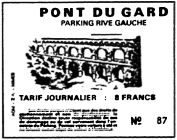
Questions et réponses, suite
B. Look at me.
Your instructor is going to give you a series of commands from the list below, not necessarily in the order followed here. He or she may ask you to repeat some of them, but for the moment we primarily want you to listen, understand, then comply with the "request." Your "réponse" in this exercise will be physical, not verbal.
| Regardez-moi. | Look at me. |
| (Jean-Paul), regarde ce stylo. | (John-Paul), look at that pen. |
| (Mlle F***), regardez ce livre! | (Miss F), look at this book! |
| (Fifi), donne-moi un stylo. | (Fifi), give me a pen. |
| (Jacques), rends-moi mon livre! | (Jim), give me back my book! |
| Levez-vous. | Get up. |
| (Philippe), lève-toi! | (Phillip), get up! |
| (M. G***), allez à la porte. | (Mr. G), go to the door. |
| Retournez à votre place. | Go back to your place (seat). |
| (Yves), retourne à ta place. | (Yves), go back to your seat. |
| Asseyez-vous. | Sit down. |
| (Mlle L***), ouvrez la porte. | (Miss L), open the door. |
| (Charles), ferme la porte. | (Charles), close the door. |
C. Am I looking at the door?
| —Est-ce que je regarde la porte? | teacher to student |
| —Oui, vous regardez la porte. | student to teacher |
| —Regardez la carte. | teacher to class |
| —Regarde la carte. | teacher to student A |
| —Tu regardes la carte? | teacher to student |
| —Oui, je regarde la carte. | student A to teacher |
| —Posez la même question à Mademoiselle C***. | teacher to student B; re: student C, f. |
| —Est-ce que tu regardes la carte? | student B to student C |
| —Oui, je regarde la carte. | |
| —Est-ce que vous regardez le mur? | teacher to group of students |
| —Oui, nous regardons le mur. | |
| —(Robert) regarde le mur? | teacher to student H, re: K |
| —Oui, il regarde le mur. | |
| —Est-ce que (Marie) et (Louise) regardent le mur? | |
| —Oui, elles regardent le mur. |
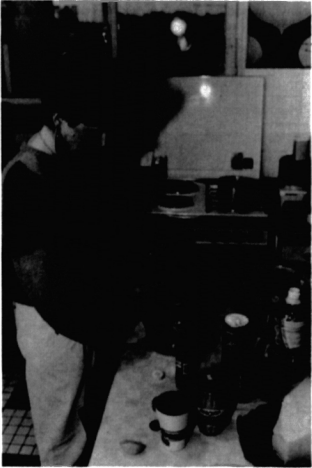 Figure 2.4. Françoise prépare le diner.
Figure 2.4. Françoise prépare le diner.This question-answer exercise continues now with the verb toucher ("to touch"), as well as regarder, and the following nouns, which are introduced by sketches, gestures, or obvious context. Don't look them up unless you absolutely have to.
| une maison | un train | une école |
| une voiture | un lit | une chambre |
| un bureau | un café |
Grammar Notes: By the end of this exercise, you should have used all present indicative forms of the verb regarder, a regular verb of the "-er" conjugation (Verb Tables, page V-1, and see below). In addition, you've used the definite article (le, la, les). You'll have more work with the definite article in the Workbook and should read the Reference Grammar, 2.2.2 and 21.
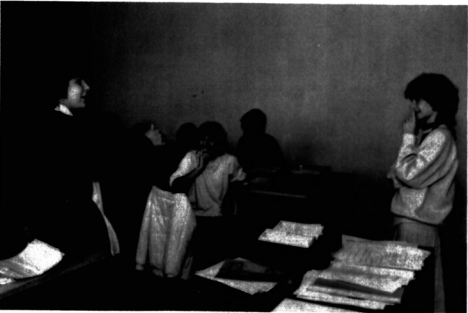 Figure 2.5. Elles se marrent?
Figure 2.5. Elles se marrent?
TROUVER, to find (CHERCHER, to look for; AIMER, to like, love)
| J'aime Susanne. | I love Susan. |
| Tu cherches un taxi. | You're looking for a taxi. |
| Il trouve le livre. | He finds the book. |
| Nous aimons le professeur. | We like the professor. |
| Vous regardez la photo. | You're looking at the photo. |
| Elles trouvent des cartes. | They find some maps. |
| Passé composé: j'ai trouvé, ... | |
| Imparfait: je regardais, ... | |
| Futur: je chercherai, ... | Futur proche: je vais aimer, ... |
Questions et réponses, suite
D. Is he happy? No, he isn't happy.
|
—Est-il content? |
|
|
—Non, il n'est pas content. |
|
|
—Est-ce que (Marie) est contente? |
|
|
—Non, elle n'est pas contente. |
|
|
—Vous êtes contents? |
teacher to group of students |
|
—Non, nous ne sommes pas contents. |
|
|
—(Jean), es-tu content? |
|
|
—Non, je suis triste. |
|
|
—Pose la même question à ta voisine. |
|
|
—Es-tu contente? |
|
|
—Non, je ne suis pas contente. |
|
E. Are you looking at the wall? No, I'm not looking at the wall.
|
—Vous regardez le mur? |
|
|
—Non, je ne regarde pas le mur. |
|
|
—Est-ce que (Marie et Françoise) regardent le mur? |
|
|
—Non, elles ne regardent pas le mur. |
|
|
—Posez la même question à votre voisin. |
|
|
—Regardes-tu le mur? |
|
|
—Non, je ne regarde pas le mur. |
|
|
—Tiens, tu regardes le mur? |
|
|
—Non, je regarde la porte. |
|
Grammar Notes: In these two short exercises (D. and E.), you have used the simple negative construction (Reference Grammar, 17.2.1) in answer to "yes/no" questions. Note that, as in English, you can answer such questions by saying, "No, I am/do not X," or obviously, "No," plus a statement to the contrary. (For example, in answer to "Are you happy?" one can say, "No, I'm not happy," or "No, I'm sad.")
F. Is this a theater? Is this a big boat?
-
—C'est un théâtre?
-
—Oui, c'est un théâtre.
-
—C'est un grand bateau?
-
—Non, c'est un petit bateau.
-
—Ce sont des clés?
-
—Non, ce ne sont pas des clés.
-
—Ce sont des bateaux?
-
—Non, ce sont des magasins.
-
—C'est un bon professeur?
-
—Non, c'est un mauvais professeur.
-
—C'est une grande ville?
-
—Oui, c'est une grande ville.
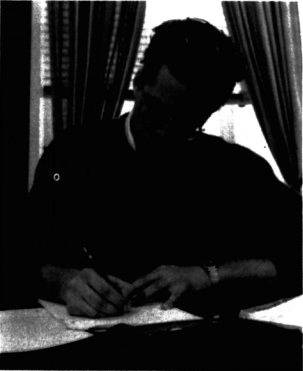
Figure 2.7. C'est un cerveau.
As exercise F. continues orally in class, you'll use nouns and adjectives from both this lesson and the previous one, perhaps even some others. The important thing is to know what your instructor or fellow student is talking about. Adjective order and form is discussed in the Reference Grammar, 2.4, and is treated in a later lesson, but for now just follow the models given to you.
The Cardinal Numerals from 0 to 29
Regardez et répétez:
|
0. zéro |
10. dix |
20. vingt |
|
1. un |
11. onze |
21. vingt et un |
|
2. deux |
12. douze |
22. vingt-deux |
|
3. trois |
13. treize |
23. vingt-trois |
|
4. quatre |
14. quatorze |
24. vingt-quatre |
|
5. cinq |
15. quinze |
25. vingt-cinq |
|
6. six |
16. seize |
26. vingt-six |
|
7. sept |
17. dix-sept |
27. vingt-sept |
|
8. huit |
18. dix-huit |
28. vingt-huit |
|
9. neuf |
19. dix-neuf |
29. vingt-neuf |
In addition to using the list above in the exercise on age on p. 23 (if you dare, ask your instructor her or his age to obtain, perhaps, a number above twenty-nine), your instructor will do oral exercises similar to the ones you did in Chapitre Un. You can prepare for these class exercises by doing the workbook exercises, particularly by working with the tape program.
Vocabulaire
NOMS (Nouns)
| un âge | age (used mainly m the expression, "How old...?") |
| un bateau | boat |
| un bureau | desk, office |
| un café | coffee, café |
| une carte | map, card |
| une chambre | bedroom |
| une chose | thing |
| une cuisine | kitchen |
| une école | school |
| un lit | bed |
| un magasin | store |
| une maison | house |
| une question | question |
| un théâtre | theater |
| une tour | tower |
| un train | train |
| une ville | city, town |
| une voiture | car |
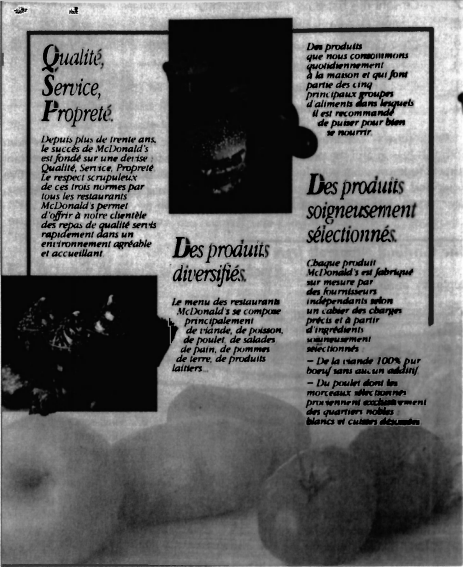
VERBES (Verbs)
| s'asseoir | to sit down |
| avoir | to have (many idiomatic uses; see exercise A. for one) |
| fermer | to close, shut |
| se lever | to get up |
| marcher | to walk, go (in the sense of "to function, operate") |
| ouvrir | to open |
| regarder | to look at |
| retourner | to return, go back |
| toucher | to touch (toucher un chèque, cash a check) |
ADJECTIFS (Adjectives)
| beau, belle | handsome (good-looking), beautiful |
| grand, -e | big, large, tall |
| mauvais, -e | bad |
| même | same |
ADVERBES (Adverbs)
| très | very |
| vite | quickly, last |

